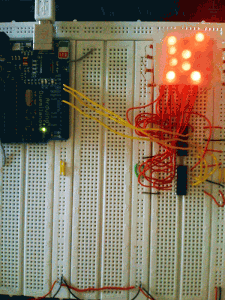5. November 2010

 Beim Eingeben eines "o" wird ein "OK" über die LED-Matrix ausgegeben, bei der Eingabe eines "n" ein "NO". Die Matrix wird über zwei 74HC595-Chips angesteuert, die mittels Serial OUT/IN miteinander verbunden sind.
Beim Eingeben eines "o" wird ein "OK" über die LED-Matrix ausgegeben, bei der Eingabe eines "n" ein "NO". Die Matrix wird über zwei 74HC595-Chips angesteuert, die mittels Serial OUT/IN miteinander verbunden sind.

//**************************************************************//
// Name : shiftOutCode, Predefined Dual Array Style //
// Author : Carlyn Maw, Tom Igoe //
// Date : 25 Oct, 2006 //
// Version : 1.0 //
// Notes : Code for using a 74HC595 Shift Register //
// : to count from 0 to 255 //
//****************************************************************
//Pin connected to ST_CP of 74HC595
int latchPin = 8;
//Pin connected to SH_CP of 74HC595
int clockPin = 12;
////Pin connected to DS of 74HC595
int dataPin = 11;
//holders for infromation you're going to pass to shifting function
byte dataRED = B11111001;
byte dataGREEN = B10011111;
byte dataArray1[2];
byte dataArray2[2];
byte INtext = 0;
void setup() {
//set pins to output because they are addressed in the main loop
pinMode(latchPin, OUTPUT);
Serial.begin(9600);
//function that blinks all the LEDs
//gets passed the number of blinks and the pause time
blinkAll_2Bytes(5,100);
}
void loop() {
if (Serial.available() > 0) {
INtext = Serial.read();
if (INtext == 'o') {
Serial.println("OK");
setOK();
} else if (INtext == 'n') {
Serial.println("NO");
setNO();
} else {
Serial.println("--");
}
//ground latchPin and hold low for as long as you are transmitting
digitalWrite(latchPin, 0);
//move 'em out
shiftOut(dataPin, clockPin, dataArray1[0]);
shiftOut(dataPin, clockPin, dataArray1[1]);
//return the latch pin high to signal chip that it
//no longer needs to listen for information
digitalWrite(latchPin, 1);
delay(500);
//ground latchPin and hold low for as long as you are transmitting
digitalWrite(latchPin, 0);
//move 'em out
shiftOut(dataPin, clockPin, dataArray2[0]);
shiftOut(dataPin, clockPin, dataArray2[1]);
//return the latch pin high to signal chip that it
//no longer needs to listen for information
digitalWrite(latchPin, 1);
delay(500);
//ground latchPin and hold low for as long as you are transmitting
digitalWrite(latchPin, 0);
//move 'em out
shiftOut(dataPin, clockPin, 0);
shiftOut(dataPin, clockPin, 0);
//return the latch pin high to signal chip that it
//no longer needs to listen for information
digitalWrite(latchPin, 1);
delay(500);
}
}
void setOK () {
// "O"
dataArray1[0] = B11111001;
dataArray1[1] = B10011111;
// "K"
dataArray2[0] = B01010011;
dataArray2[1] = B00110101;
}
void setNO () {
// "N"
dataArray1[0] = B10011101;
dataArray1[1] = B10111001;
// "O"
dataArray2[0] = B11111001;
dataArray2[1] = B10011111;
}
// the heart of the program
void shiftOut(int myDataPin, int myClockPin, byte myDataOut) {
// This shifts 8 bits out MSB first,
//on the rising edge of the clock,
//clock idles low
//internal function setup
int i=0;
int pinState;
pinMode(myClockPin, OUTPUT);
pinMode(myDataPin, OUTPUT);
//clear everything out just in case to
//prepare shift register for bit shifting
digitalWrite(myDataPin, 0);
digitalWrite(myClockPin, 0);
//for each bit in the byte myDataOut�
//NOTICE THAT WE ARE COUNTING DOWN in our for loop
//This means that %00000001 or "1" will go through such
//that it will be pin Q0 that lights.
for (i=7; i>=0; i--) {
digitalWrite(myClockPin, 0);
//if the value passed to myDataOut and a bitmask result
// true then... so if we are at i=6 and our value is
// %11010100 it would the code compares it to %01000000
// and proceeds to set pinState to 1.
if ( myDataOut & (1<<i) ) {
pinState= 1;
}
else {
pinState= 0;
}
//Sets the pin to HIGH or LOW depending on pinState
digitalWrite(myDataPin, pinState);
//register shifts bits on upstroke of clock pin
digitalWrite(myClockPin, 1);
//zero the data pin after shift to prevent bleed through
digitalWrite(myDataPin, 0);
}
//stop shifting
digitalWrite(myClockPin, 0);
}
//blinks the whole register based on the number of times you want to
//blink "n" and the pause between them "d"
//starts with a moment of darkness to make sure the first blink
//has its full visual effect.
void blinkAll_2Bytes(int n, int d) {
digitalWrite(latchPin, 0);
shiftOut(dataPin, clockPin, 0);
shiftOut(dataPin, clockPin, 0);
digitalWrite(latchPin, 1);
delay(200);
for (int x = 0; x < n; x++) {
digitalWrite(latchPin, 0);
shiftOut(dataPin, clockPin, B11111111);
shiftOut(dataPin, clockPin, B11111111);
digitalWrite(latchPin, 1);
delay(d);
digitalWrite(latchPin, 0);
shiftOut(dataPin, clockPin, 0);
shiftOut(dataPin, clockPin, 0);
digitalWrite(latchPin, 1);
delay(d);
}
}